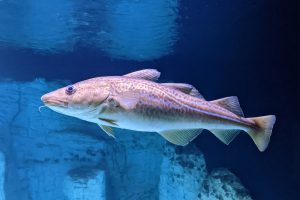Examining the future of fishery-independent surveys as a Hollings Scholar
One of two UW Marine Biology students who were chosen as NOAA Hollings Scholars for 2024-2026, the next step for Hannah Tucker was to apply for her 2025 summer internship. Taking place over 10 weeks, Hannah’s internship will be exploring the future of fishery-independent surveys in the northeast in Woods Hole, Massachusetts (MA). We caught up with Hannah about how she chose the internship, what it will involve, and what she’s most looking forward to regarding the experience.
How did you choose this particular internship?
I applied to lots of internships and tried to be as diverse as possible with my applications. I was excited about this one because of the location and exposure to new topics.
Tell us, what exactly is a fishery-independent survey?

A fishery-independent survey is a model that estimates the future of a population’s stock trends based on previously collected data. NOAA’s Northeast Fisheries Science Center (NEFSC) has been conducting a survey on New England groundfish populations for many years by collecting fish from boat trawls. The fishery-independent surveys I will be working on combine how both environmental changes (climate change, changing fish distribution) and sampling error (gaps in data, COVID-19, construction of windmills obstructing boat paths) alter previously constructed models on stock trends and abundance to help inform fisheries management. My project will aim to statistically implement these changes to better estimate the population trend of a specific New England groundfish species.
What organization will you be working with?
I will be working in Woods Hole, MA at the population dynamics branch within NOAA’s Northeast Fisheries Science Center.
Did you know, NOAA Fisheries’ first laboratory was founded in Woods Hole in 1871, and the Northeast Fisheries Science Center covers over 160,000 sq miles of ocean from North Carolina to Maine.
What kind of activities will the internship involve?
First, I will work with my supervisors to design a research plan and main question related to the NEFSC bottom trawl survey. Once I have a specific topic, I will mainly be working with data and conducting statistical analysis within R, a programming language for statistical computing and data visualization.
How long will the internship last?
All Hollings Scholars have an internship that lasts 10 weeks. For schools on the semester system, the program is set up so the 10th week is spent at the Hollings Symposium in DC during the last week in July. Since UW is on the quarter system, I will likely travel back to my internship site in Cape Cod to finish the last three weeks and finalize my results after the symposium.
Find out more about NOAA’s Ernest F. Hollings Undergraduate Scholarship.
What are you most excited about for this internship?
I am most excited about the opportunity to gain experience handling large datasets and working in R. I have a very basic skillset in data analysis, and I am hoping to learn a lot more (especially in science that is critical in informing real-life ecosystem management). It might not be the most glamorous aspect of research, but becoming comfortable analyzing results is important, and I look forward to being comfortable doing this myself.
How has your study experience so far at UW prepared you for this upcoming internship?
The basic statistical analysis tools that I have learned from classes at UW will definitely help me, as well as the familiarity with R and Github I have gained from being involved in Dr. Chelsea Wood’s lab this past year.